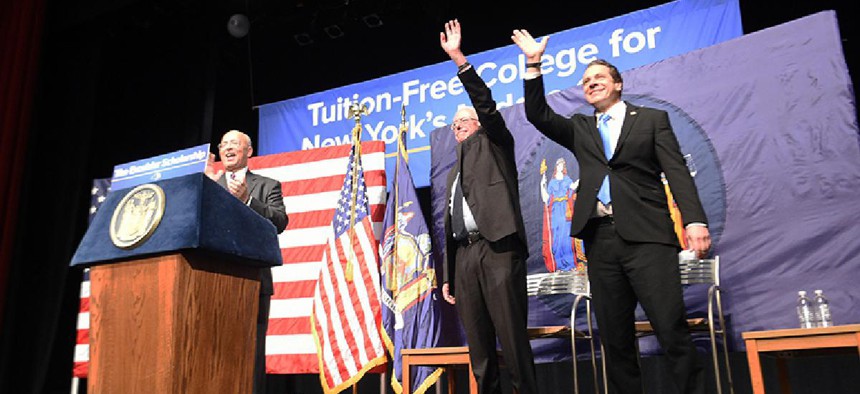Andrew Cuomo
The price of free: The Excelsior Scholarship may come with a cost

Kevin P. Coughlin / Office of the Governor
In January, Gov. Andrew Cuomo proposed the Excelsior Scholarship, which will subsidize tuition for families making $100,000 or less in the 2017-2018 school year, and for families making $125,000 or less by fall 2019. The governor was joined by U.S. Sen. Bernie Sanders at the event announcing the program, with the populist 2016 presidential candidate who championed the idea of free tuition seeming to burnish Cuomo’s progressive credentials. When the bill was signed into law in April as part of the state budget, the governor was joined by Hillary Clinton. However, the fanfare surrounding the program may obscure some of the complaints about it.
Eligible students attending State University of New York or City University of New York schools could receive up to $5,500 through the scholarship, minus amounts from federal Pell Grants or the state’s Tuition Assistance Program. Universities will cover the rest of the costs through tuition credits. There is a minimum academic credit requirement and, in a change sought by state Senate Republicans, students must remain in the state for the same number of years that they received the scholarship.
RELATED: Leaving behind No Child Left Behind
H. Carl McCall, chairman of the SUNY board of trustees, praised the Excelsior Scholarship. He noted how the various scholarships available to students would provide coverage tantamount to free tuition. He also touted the number of students who had applied for the scholarship.
“Some 70,000 students have applied – 50,000 at SUNY, and I believe 20,000 at CUNY,” McCall said during City & State’s “On Education” event on Aug. 16. During the initial Excelsior Scholarship application period from June 7 and July 21, the state said 75,000 students had applied. “We’ve seen at SUNY 18,000 more students enrolling this year than in the past and I think this has something to do with it,” McCall said.
While high registration numbers may be a marker of the new program’s success, it also presents some challenges. The state previously projected that only 23,000 students can be covered under the scholarship. A state official said that the July 21 deadline had been extended into August, so that students who were unaware of certain requirements could update their applications. Updated numbers for how many students have applied, and how many will be accepted, should become available after Labor Day.
Even if the number of students that are granted an Excelsior Scholarship exceeds 23,000, Assemblyman Ed Ra, a member of the Assembly’s Education Committee, said the strict requirements for the Excelsior Scholarship may mean it will not extend to many New Yorkers.
“There are going to be plenty of families that struggle to pay for their children to go to college that are going to be above the income threshold.” – Assemblyman Ed Ra
“There are going to be plenty of families that struggle to pay for their children to go to college that are going to be above the income threshold,” Ra said at City & State’s education event. “I think the real unfortunate thing is as that budget was adopted, there was also an authorization for a tuition increase,” he added, referring to the decision by the SUNY board of trustees in June to raise tuition 3.1 percent.
RELATED: Charters rekindle controversy over teacher training requirements
Chika Onyejiukwa, chairwoman of the CUNY University Student Senate and the only student member of the CUNY board of trustees, agreed that many students may not end up receiving benefits from the Excelsior Scholarship.
“The program creates such stringent criteria that many of our students, although they have applied, they may not get the opportunity to explore this program,” Onyejiukwa said. “So what they’re stuck with is paying their own tuition and then on top of that are tuition hikes.” She added that “the criteria are not there yet” for making the Excelsior Scholarship truly equivalent to free tuition.
With stringent requirements, a hefty price tag for the state and a significant gap between the number of students who applied and the number of students who will receive the scholarship, Cuomo’s plan may be less utopian than it originally appeared. However, as McCall noted, it is a concrete measure toward making higher education more accessible.
“Fifty percent of our resident undergraduates will be able to attend SUNY tuition free,” McCall said. “Now, it’s true, tuition isn’t the only expense, but that is certainly a big difference in terms of affordability and the ability to go to college.”
Onyejiukwa agreed that as an education advocate, and a student, the creation of the Excelsior Scholarship was an important development.
“We are taking a step in the right direction, but at the same time understanding the impact of the program long term,” she said.